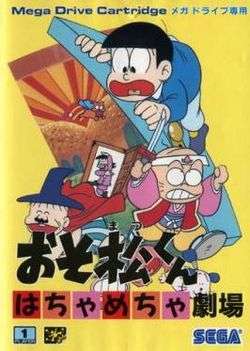Osomatsu-kun: Hachamecha Gekijō
 Cover art | |
| Developer(s) | Sega[1] |
|---|---|
| Publisher(s) | Sega[1] |
| Platform(s) | Sega Mega Drive |
| Release date(s) | |
| Genre(s) | Platform[1] |
| Mode(s) | Single-player |
Osomatsu-kun: Hachamecha Gekijō (おそ松くん はちゃめちゃ劇場, "Nonsense Theater") is a platform video game by Sega, which was released in 1988 for the Sega Mega Drive.[1] It was one of the first four games released on the system during the Mega Drive's introduction; however, it was only released in Japan. The game was based on the Manga/Anime series Osomatsu-kun by Fujio Akatsuka; players controlled the title character and encountered many of the series' characters in a strange (but comical) world.[1]
Gameplay

The player controls Osomatsu (leader of the sextuplets) through a total of three stages, armed only with a short-range slingshot. Each stage has a distinct path the players need to follow in order to proceed, though each stage has a variety of different places to go. By pressing the "up" button at an open door the player enters another section of the level, where different items await. By falling into a hole the player enters an underground (or underwater) level, and by jumping on the back of a turtle (or a floating golden platform), the player will be taken to a cloud-world (or somewhere else). In order to fight the boss of each stage, the player has to locate and defeat the stage's mini-boss (Chibita or Dekapan) in order to locate and defeat Iyami, the stage's boss. Every time a boss or mini-boss is defeated, Osomatsu becomes stronger; his life-bar and slingshot distance both increase.
The player can enter shops (run by Totoko) where they can purchase power-up items which grant limited powers (the player's inventory is located on the "pause" screen). The shops also have mini-games, such as a slot machine and a small path-finding game. The player starts each game with three lives, and cannot earn any "continues." Additional lives are awarded by collecting six 1-Up Cards, which are located randomly at each level.
Items
Normal
- Ribbons: Currency needed to gamble or buy items from Totoko's shop
- Ramune: Increases Osomatsu's health slightly
- Cupcake: Increases Osomatsu's health moderately
- Chocolate Bar: Increases Osomatu's health greatly
- Ramen: Increases Osomatsu's health even more
- Totoko Doll: Completely restores Osomatsu's health
- 1up Card (bearing Osomatsu's face): collecting six gives a player an extra life
Special
- Wings: Allow Osomatsu to fly for a short time, but disables his ability to attack
- Octopus: Allows Osomatsu to run faster
- Fireworks: Damage any enemies nearby
- Monk's Robe: Makes Osomatsu temporarily invincible
- Karashi: Destroys all small enemies on the screen
- Bone Fish: Summons a small cat to help defeat nearby enemies